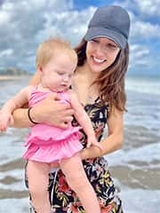Treatment for Congenital Hypothyroidism Before Birth: Jane’s Story
Treatment for Congenital Hypothyroidism Before Birth: Jane’s Story
Like most expectant parents, Anna and Brent were excited for the 20-week anatomy scan of their unborn baby. In addition to learning the sex of their baby, they learned their daughter had an unusually large mass on her throat. Doctors near their home in Virginia suspected it was one of three things – a tumor, a cyst or a goiter – all of which sounded terrifying to the first-time parents.

The couple was referred to the Richard D. Wood Jr. Center for Fetal Diagnosis and Treatment at Children’s Hospital of Philadelphia (CHOP) for further testing. Within a week, Anna and Brent were in Philadelphia for a full day of prenatal testing that included a detailed fetal ultrasound, MRI and echocardiogram, followed by a comprehensive consultation with doctors. Guiding the scared couple through the evaluation was Fetal Therapy Coordinator Deanna Ruble, BSN, RN,C-NIC.
“The first day, doctors showed us pictures of the large goiter (enlarged thyroid gland) our baby had developed on her throat,” Anna says. “They strongly suspected a thyroid condition rather than a tumor – so that was somewhat comforting – but we needed more testing to determine if it was my thyroid or the baby’s that was causing the issue.”
Specialized prenatal testing for thyroid disorders
Initial testing performed on Anna revealed that her thyroid was functioning normal. This made the doctors very concerned that the baby’s thyroid was not functioning the way that it should. At the end of the initial evaluation, the clinical team, including a maternal-fetal medicine specialist, discussed potential diagnostic and treatment options with Anna and Brent.

To test the baby’s thyroid in utero, a fetal blood sample would need to be collected. This requires a special procedure called percutaneous umbilical blood sampling (PUBS). The procedure is done in the operating room under maternal sedation and can be risky.
Treatment would depend upon the results of the fetal blood sample. Ultimately, Anna opted to go forward with the fetal blood sampling and testing confirmed the baby’s thyroid was not producing enough thyroid hormone (which had caused the goiter), and the baby was diagnosed with hypothyroidism.
Though hypothyroidism is a common endocrine disorder, it is very rarely diagnosed before birth or known to cause goiters to form prenatally. Untreated hypothyroidism can lead to poor growth, intellectual delay and many other issues. The growth on the baby’s throat was particularly concerning to doctors because it could impact the baby’s airway during or immediately after birth.
Treating hypothyroidism before birth
The team recommended treating the baby before birth with infusions of thyroid hormone into the amniotic sac in an attempt to decrease the size of the goiter before birth.
For the second half of Anna’s pregnancy, she returned to CHOP weekly for regular prenatal monitoring and serial infusions of thyroid hormone into the amniotic sac. The baby’s growth and the size of the goiter were regularly monitored so doctors could adjust the dosage as the baby grew in utero.
Because of the need for frequent monitoring, Anna moved into the Ronald McDonald House in Philadelphia at 34-week gestation to be closer to the hospital in case labor started early. Her mother stayed with her, while Brent remained in Roanoke, Virginia, for work until the delivery.
The good news was that the thyroid hormone worked, and the goiter did not seem large enough to cause airway obstruction. This meant that Anna could have a natural delivery.
Welcoming baby Jane

On Nov. 2, 2021, Anna came to CHOP for her 38-week prenatal appointment. It was supposed to be her last prenatal appointment and the baby’s final infusion before a planned induction of labor the following week in CHOP’s Garbose Family Special Delivery Unit, the nation’s first birth center in a pediatric hospital for mothers carrying babies with known birth defects.
But instead of giving Anna the all-clear to return to the Ronald McDonald House for another week, doctors said they would be inducing labor in anticipation of delivery that night. Though the baby’s goiter had shrunk considerably, there was a slight increase in its size and directly treating the baby after birth seemed to be the better option. They wanted to assess the baby outside her mother’s womb and administer treatment if needed.
Anna immediately called Brent, who quickly drove to Philadelphia to be by his wife’s side. Jane was born at 3:01 a.m. on Nov. 5. Brent was able to cut the umbilical cord.
Care after delivery
After birth, Jane’s condition was immediately assessed. Anna was able to hold and bond with her daughter in the first hour of life – a critical period when skin-to-skin care can help regulate the baby’s temperature, breastfeeding can be initiated and the mother-baby bond optimized. Those early minutes meant a lot of Anna and helped her achieve the birth plan goals she had set before she knew of her daughter’s health challenges.
Jane was then transported to the Newborn/Infant intensive Care Unit (N/IICU) for further evaluation. At first, Jane struggled a bit with breathing issues during feedings and remaining at CHOP for 10 days for observation before being discharged home to Virginia.
Home sweet home

Jane has been home for nearly a year now and is doing great, her mom says.
“She’s the happiest baby,” says Anna. “She very rarely cries. She’s standing on her own and is super close to walking. She’ll take a few steps now if she’s holding our hands.”
Jane loves interacting with the family’s pets, dog Radley, and cat Rick James. She enjoys spending time outdoors watching the water and leaves, likes swinging and going down the slide, and spending time with her parents. Now a year old, Jane is talking quite a bit – she says “I love you” to her parents – and is learning some sign language to enhance her early communication skills.
“Jane eats everything we put in front of her,” Anna adds, “and she hasn’t met a food she doesn’t love!”
Jane will need continued monitoring for her thyroid condition and medication for the rest of her life, but for the most part, her condition should not hold her back from accomplishing her own dreams – whatever they may be.
For now, Anna is enjoying her time at home, bonding with her “miracle” baby. She and Brent say they’ll be forever grateful to the team of doctors, nurses and support staff at CHOP.
“The team made sure we were comfortable with the treatment plan, the birth plan and the plan to transition Jane’s care closer to our home in Virginia after birth," Anna says. "We can’t thank them enough for all they’ve given us.”